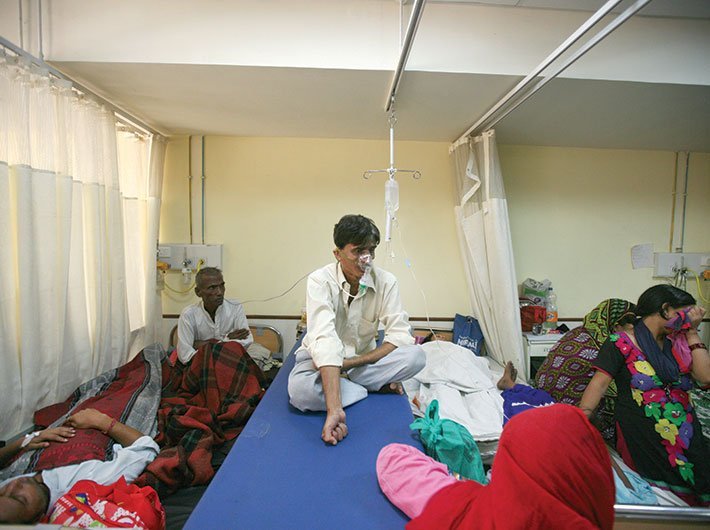The union budget allocations for the health sector have stagnated at 0.3 percent of GDP, and it would require a much greater thrust to achieve the public financing target by 2025
In the union budget for 2018-19, some big announcements have been made especially for the health sector but not supported by corresponding budgetary allocations. While, on the one hand, allocations for some of the key programmes have not shown any increase, on the other, promises have been made for rolling out a big insurance scheme for the poor with no specific budgetary provisions.
The total allocations for the ministry of health and family welfare (MoHFW) (including AYUSH) have increased only marginally by 2.5 percent from Rs 54,852 crore in 2017-18 (Revised Estimates or RE) to Rs 56,226 crore in 2018-19 (Budget Estimates or BE). The National Health Policy (NHP) 2017 targets a total level of public expenditure on health (by both centre and states) at 2.5 percent of GDP by 2025, of which 40 percent should come from the centre amounting to one percent of GDP. However, the union budget allocations for the health sector have stagnated at 0.3 percent of GDP, and it would require a much greater thrust to achieve the public financing target by 2025.
The flagship programme National Health Mission (NHM), constituting more than half of the total health budget, witnesses a decline of about two percent from 2017-18 (RE). For one of the important segments under NHM, namely maternal and child health, the allocations for some specific schemes also witness reductions. The Reproductive and Child Health (RCH) component declines in 2018-19 (BE) by 33 percent over 2017-18 (RE). Along with this, the allocation for Pradhan Mantri Matru Vandana Yojana (PMMVY), the erstwhile maternity benefit scheme, has also reduced by eight percent over 2017-18 (RE). This decline towards maternal and child health interventions acquires significance as India accounts for nearly 15 percent of global maternal deaths each year (2015) and has the largest number of women affected by anaemia in the age-group of 15-49 years.
It is well known and recently highlighted by the CAG audit of NHM that there are gaping shortfalls in healthcare infrastructure and human resources across the states. The primary healthcare needs strengthening as promised by NHP 2017. Here, allocation of Rs 1,200 crore announced for the Health and Wellness Centres (HWCs) is a welcome step, but the upgrading of 1.5 lakh sub-centres to HWCs was announced in the union budget 2017-18 and until now not much has happened on that front. The budget also announces establishment of 24 new medical colleges by upgrading district hospitals, however, it is a little surprising that allocations for this have actually decreased from Rs 3,300 crore in 2017-18 (RE) to Rs 2,888 crore in 2018-19 (BE). Moreover, the government has invited private sector participation in establishment of HWCs. Such a move needs to be looked at carefully because a large section of population in India who is poor and vulnerable depends on public provisioning of healthcare.
With the announcement of National Health Protection Scheme (NHPS), the government promises a big move towards universal health coverage where ‘coverage’ implies expanding the insurance cover. In a rush towards touting NHPS as the “world’s largest government funded healthcare programme” with 50 crore prospective beneficiaries to be financed through Rs 11,000 crore from health and education cess of 4 percent, it is somehow forgotten that NHM, operational since 2005, is already covering 125 crore people with Rs 31,000 crore allocation at present. NHPS seems to be a scaled-up version of Rashtriya Swasthya Bima Yojana (RSBY), an insurance scheme which has not proved very successful in reducing the healthcare cost for the poor. The out-of-pocket (OOP) expenditure in India remains high at 63 percent of the total health expenditure, which is largely due to high costs incurred on private healthcare and expenditure on medicines and diagnostics. Many states have in fact opted out of RSBY in favour of state-run schemes, and some states are trying out the trust-based model.
An uncharted course towards insurance and privatisation may not augur well for a country like India where even basic healthcare facilities do not exist in various regions and the costs of healthcare are catastrophic. India is still struggling to deal with large disparities in healthcare provisioning across economic classes, social categories and geographical regions. There are worthy examples in some developing countries like Brazil and Thailand which have successfully attempted universalisation of healthcare. Thus, for India to achieve a healthy Bharat and realise the vision of New India 2022, there is a need to carefully rethink the policy framework for the health sector. For an ‘Ayushman Bharat’, the government should be working towards making health a fundamental right and ensuring public provisioning for universal healthcare.
Chintan works with Centre for Budget and Governance Accountability. Views are personal.


